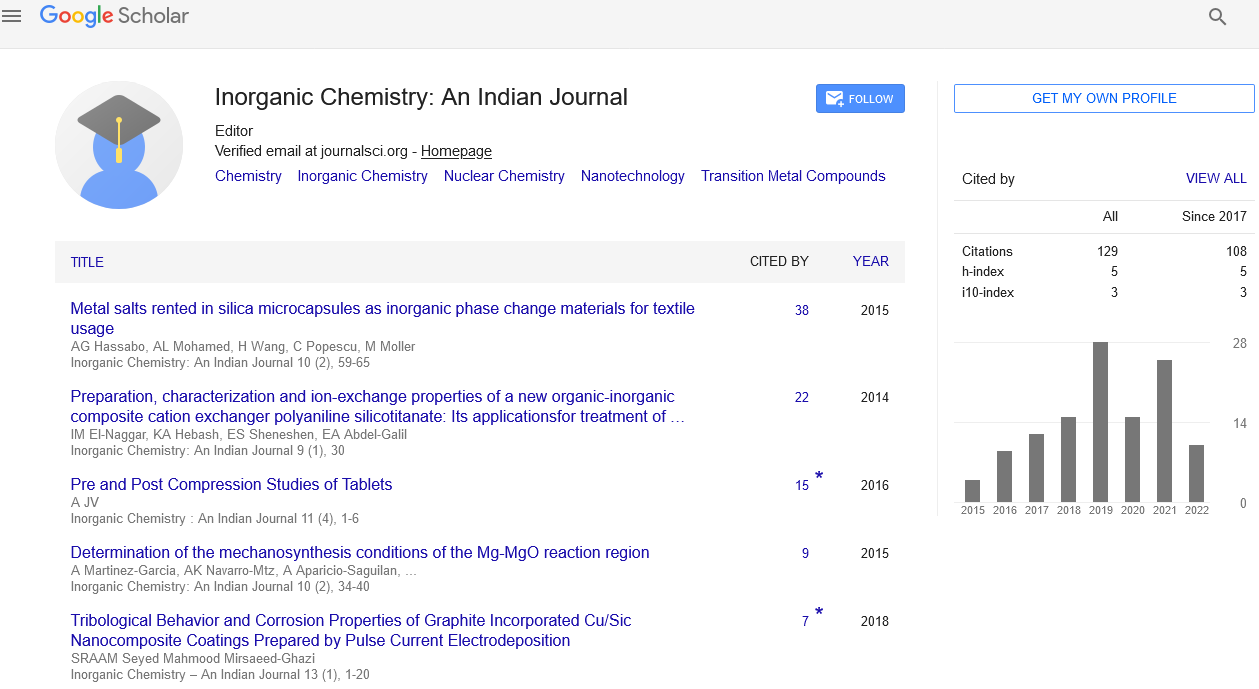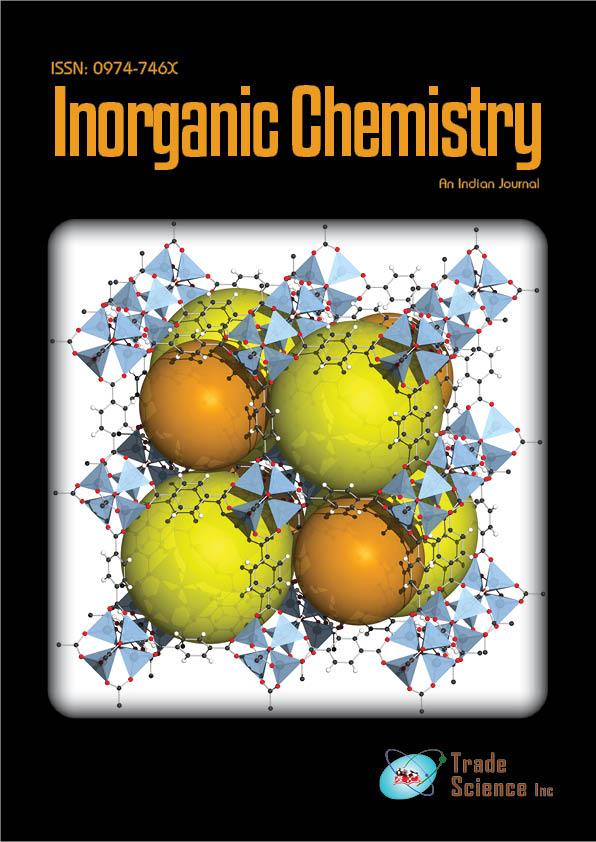About
Inorganic Chemistry: An Indian Journal is a multidisciplinary, Peer-reviewed, Open Access Journal, dedicated to latest advancements in all area of inorganic chemistry with unwavering focus of rapid and pre-eminent publication.
Aims & Scope
- Emphasize global dissemination of information by scientists, academicians, Research Scholars with respect of current inventions, developments in all phases of inorganic chemistry.
- Inorganic Chemistry: An Indian Journal provides an effective way to publish Original articles, reviews, short communications, rapid communications, letters to the editor and case-reports.
- Journal publishes papers of outstanding significance, ground-breaking discoveries in inorganic chemistry which covers broad coverage of Coordination Chemistry, Organometallic Chemistry, Bioinorganic Chemistry, Nuclear Chemistry, Nanotechnology,Transition Metal Compounds, Main-group Compounds, Cluster Compounds , Mechanisms of Inorganic Reactions, and relevant aspects of Industrial Inorganic Chemistry, Theoretical Inorganic Chemistry such as Qualitative theories, Molecular symmetry group theory and Chemical Bonding Theory.
- Inorganic Chemistry: An Indian Journal publishes one volume each year with new articles being added instantly. The journal encourages research scientists, faculty, and students who are actively involved in scientific research and/or teaching at all levels, to submit their articles for intensive peer-reviewing and expedite publishing. Individuals from small and non-research oriented institutions are especially encouraged to submit their original articles for publication consideration.
- The articles will be managed electronically, examined by a scientific committee and anonymous evaluators and published every month in HTML and PDF formats.
- Submit manuscript as an Email attachment to the Editorial Office: publisher@tsijournals.com
Fast Editorial Execution and Review Process (FEE-Review Process):
Inorganic Chemistry : An Indian Journal is participating in the Fast Editorial Execution and Review Process (FEE-Review Process) with an additional prepayment of $99 apart from the regular article processing fee. Fast Editorial Execution and Review Process is a special service for the article that enables it to get a faster response in the pre-review stage from the handling editor as well as a review from the reviewer. An author can get a faster response of pre-review maximum in 3 days since submission, and a review process by the reviewer maximum in 5 days, followed by revision/publication in 2 days. If the article gets notified for revision by the handling editor, then it will take another 5 days for external review by the previous reviewer or alternative reviewer.
Acceptance of manuscripts is driven entirely by handling editorial team considerations and independent peer-review, ensuring the highest standards are maintained no matter the route to regular peer-reviewed publication or a fast editorial review process. The handling editor and the article contributor are responsible for adhering to scientific standards. The article FEE-Review process of $99 will not be refunded even if the article is rejected or withdrawn for publication.
The corresponding author or institution/organization is responsible for making the manuscript FEE-Review Process payment. The additional FEE-Review Process payment covers the fast review processing and quick editorial decisions, and regular article publication covers the preparation in various formats for online publication, securing full-text inclusion in a number of permanent archives like HTML, XML, and PDF, and feeding to different indexing agencies.
https://maviyolculuk.online/
https://mavitur.online/
https://marmaristeknekirala.com.tr
https://tekneturumarmaris.com.tr
https://bodrumteknekirala.com.tr
https://gocekteknekirala.com.tr
https://fethiyeteknekirala.com.tr
*2016 Journal Impact Factor was established by dividing the number of articles published in 2014 and 2015 with the number of times they are cited in 2016 based on Google search and the Scholar Citation Index database. If 'X' is the total number of articles published in 2014 and 2015, and 'Y' is the number of times these articles were cited in indexed journals during 2016 then, impact factor = Y/X
h-index
Articles published in Inorganic Chemistry: An Indian Journal have been cited by esteemed scholars and scientists all around the world. Inorganic Chemistry: An Indian Journal has got h-index 6 , which means every article in Inorganic Chemistry: An Indian Journal has got 6 average citations.
Recently Published Papers
Electrochemical degradation of antivirus drug-lamivudine formulation: photoelectrocoagulation, peroxi-electrocoagulation and peroxi-photoelectrocoagulation processes
Author(s): Samuel Fekadu
..
Short communication, . 2022 Vol: 17( 1)
Green Hydrogen Production in MENA and its Export to Western Europe: Techno-Economic Assessment
Author(s): Mohamed Amine Essafi
..
Short communication, . 2022 Vol: 17( 1)
The Novel Method for Measurement of Sulphur in Petcoke from Crude Oil
Author(s): Dhiraj Gondaliya
..
Short communication, . 2022 Vol: 17( 1)
Short communication, . 2022 Vol: 17( 1)
Water Quality Assessment and Heavy Metal Detoxification via Bioremediation
Author(s): Priti Gupta
..
Short communication, . 2022 Vol: 17( 1)

